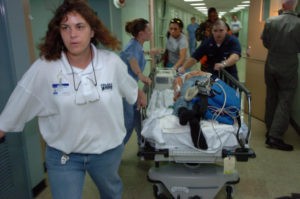Safety Principles for Preventing Patient Injury
 There are multiple opportunities for patient injury to occur. Those of us with knowledge of how the healthcare system works see that facilities use safety principles for preventing patient injury. When the system fails, the litigation system may become involved.
There are multiple opportunities for patient injury to occur. Those of us with knowledge of how the healthcare system works see that facilities use safety principles for preventing patient injury. When the system fails, the litigation system may become involved.
Consider the safety issues in this case.
A forty-two year-old woman was admitted to the hospital with chronic cellulitis infection in her left leg, uncontrolled diabetes, nausea, vomiting and diarrhea. She contracted hospital-acquired pneumonia. She stopped breathing while undergoing an esophagoastroduodenoscopy. Her estate alleged the defendant internist failed to diagnose and treat the bacterial pneumonia and that the EGD was contraindicated because of the respiratory compromise.
The estate also alleged the hospital personnel failed to timely perform chest compressions, failed to adequately perform bag/mask ventilation, performed ineffective resuscitation, delayed responding to the code blue (over 6 minutes) and failed to have a code policy in place. The jury found the hospital liable for $8 million.
Estate of Joya Pipkin, deceased v. Mount Sinai Hospital Medical Center of Chicago, Mysore Bhagavan MD, Krishnaswamy Anand and Sinai Medical Group, Cook County, IL Circuit Court No. 10L-3617
Although sometimes education is the most useful way to prevent adverse events, it is also important to make changes in the healthcare system. After an incident like this takes place, preventing patient injury involves a complex set of remedial efforts.
For example, all areas of the hospital where patients may be located should have staff taught how to perform CPR. The educational approach would involve instructing workers how to perform CPR. The systems approach would involve having a code cart at hand as well.
Lessons of High Reliability Industries in Preventing Patient Injury
Certain industries like nuclear power and commercial aviation operate under dangerous conditions yet have far better safety records than does health care. These “high reliability” industries have much to teach us about preventing patient injury. Here are some of the lessons.
1. All workers should look for and report small problems or unsafe conditions before they pose a risk to the organization and when they are easy to fix.
2. Workers should resist the urge to simplify their observations and experiences. Threats to safety can be complex and present themselves in many ways.
3. Workers should always report any abnormalities in operations. A piece of equipment could first have a subtle malfunction before a major equipment related problem develops, for example. Everyone should feel free to speak up about any concerns.
4. Workers should understand that small errors can spread and worsen. They have to be quickly contained to limit harm.
5. When a threat to patient safety occurs, the person with the greatest expertise should be given decision making authority. That person may not be the most senior or highest in rank in the organization.
I think of the healthcare system as suspended over a safety net. There are holes in the net- How tight can we make the mesh?
Listen to Valerie Lane discuss the risk aspects of health care. She has a unique vantage point as being involved in corporate risk management. Catch her interview for Legal Nurse Podcasts here.
